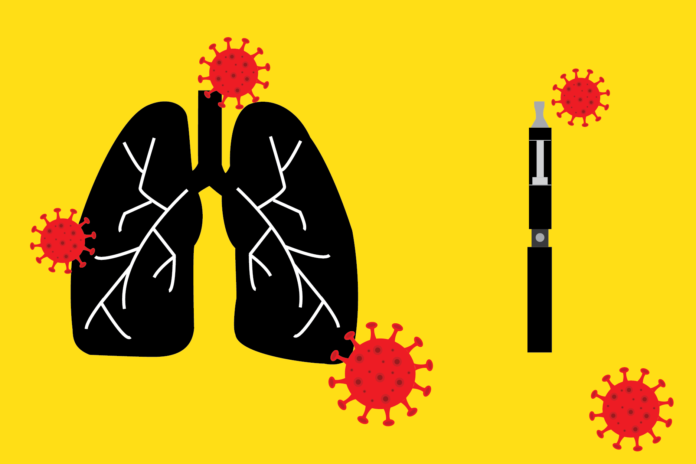Three adolescent cases demonstrate importance of patient history and e-cigarette or vaping product use-associated lung injury (EVALI) education
Respiratory distress. Fever. Nausea. All of these familiar symptoms seem to point towards a COVID-19 diagnosis. Yet Kiran Nandalike, an associate professor in the department of pediatrics at UC Davis, discovered that in three cases where these problems were presented, each patient was ultimately diagnosed with e-cigarette or vaping product use-associated lung injury (EVALI).
“It was the timing and the confusion [about] similarities between […] these EVALI cases and COVID that caught all our attention,” Nandalike said.
In a recently published study led by Nandalike, three adolescent patients from earlier this year were described to have been admitted to the UC Davis Medical Center due to respiratory distress along with other symptoms, raising concerns that they might have COVID-19.
Nandalike explained that since these cases occurred during the early stages of the pandemic, COVID-19 testing capacity was still low and there wasn’t as much knowledge on COVID-19 cases presented in children, causing many of the treating physicians to feel anxious. After testing each of these patients, the results came back negative for SARS-CoV-2. Nandalike explained that it was after looking into the vaping and smoking history of each patient that they were able to ultimately diagnose these patients with EVALI.
“It just really brings it home how important the history portion of the examination is, because if you don’t get the history of the vaping, one could just assume that it is COVID,” said Kriti Gwal, an assistant professor for pediatric radiology in the department of radiology.
Gwal explained that because there is a tremendous amount of overlap, especially with the image findings in radiology, it is extremely difficult to differentiate between the two diagnoses. She elaborated that these cases demonstrate the importance of the interdisciplinary nature of medicine. By working closely with the pediatric pulmonologists on the case, Gwal believes this close communication allowed them to create a holistic picture for each patient.
Obtaining vaping or smoking history, however, is not always an easy task. Nandalike described that it can be very challenging, especially when the patient comes in with respiratory distress and cannot communicate with the physicians or if they are always surrounded by family members. As illustrated in one of the cases in the paper, she explained that urine toxicology can help test for substances such as THC when the information cannot be obtained directly from the patient.
Daphne Darmawan, a resident physician in the UC Davis Pediatric Residency Program and first author of the paper, added that often times when physicians talk with adolescents concerning sensitive topics such as sexual health or abuse, they will talk to the patient in private to make sure the patient feels they can talk freely without worry. Nandalike also stated that this helps the physician connect with the patient and educate them more on such topics.
Similar symptoms may not be the only association between EVALI and COVID-19. In a recent study, it was found that COVID-19 risks were much higher in individuals who smoke or vape. Aside from this study, Nandalike elaborated that there have been more reports of mental health issues and substance abuse during the pandemic given the isolation and anxiety associated with it. Darmawan added that since many adolescents’ identity lies with their friends, the social isolation caused by the pandemic contributes to heightened levels of anxiety.
“From my own experience with working with patients, I had several teenagers who said ‘I’ve just been bored’ and ‘I’m more sad,’” Darmawan said. “Even if it hasn’t led to EVALI, I have had patients who are saying that they are more stressed out and feeling more depressed because of the things that are going on with the pandemic.”
As the pandemic has progressed, Nandalike stated that they have continued to encounter EVALI cases. EVALI outbreaks have continued to occur since Mar. 2019, largely linked to the presence of vitamin E acetate in some THC containing products, as explained in their paper. Darmawan added that since many adolescents obtain vape cartridges and other products from informal sources and unlicensed dealers, this increases the risk of outbreaks occurring.
In addition to being more mindful of the effects of smoking and vaping, Gwal expressed that even though adolescents are usually not at risk for COVID-19 related complications, it is still important to wear a mask, social distance and listen to CDC guidelines.
“Educate your friends and educate the community,” Nandalike said. “E-cigarettes were […] first introduced in the U.S. in 2006 [and] since then, we have learned so much and clearly it’s not any better than cigarettes. Especially these vaping products, they are known to be even more dangerous than cigarettes. So, for our teens and young adults: no smoking, no vaping, no e-cigarettes. Nothing’s safe when it comes to smoking.”
Written by: Michelle Wong — science@theaggie.org




